The iPad Air Review
by Anand Lal Shimpi on October 29, 2013 9:00 PM ESTDisplay
In building the iPad Air Apple shrunk all elements of the tablet’s design, including the thickness of the display. We’re still dealing with a 9.7-inch 4:3 2048 x 1536 IPS LCD panel with true RGB stripe rather than some weird subpixel structure. Viewing angles are still great, and overall the display remains the best you can get at this size.
![]()
The iPad Air continues Apple’s recent history of shipping color calibrated displays. Color accuracy on my iPad Air review sample is better than on any previous iPad I’ve ever tested, in fact it’s more accurate than any other tablet I’ve ever tested. The numbers are easily backed up by images that show a vibrant and, more importantly, accurate display.
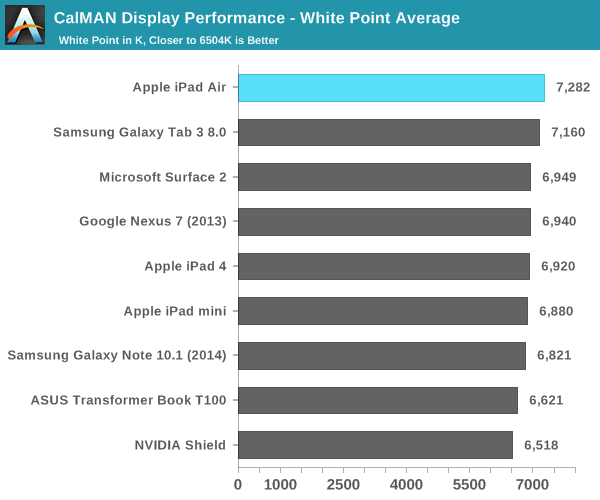
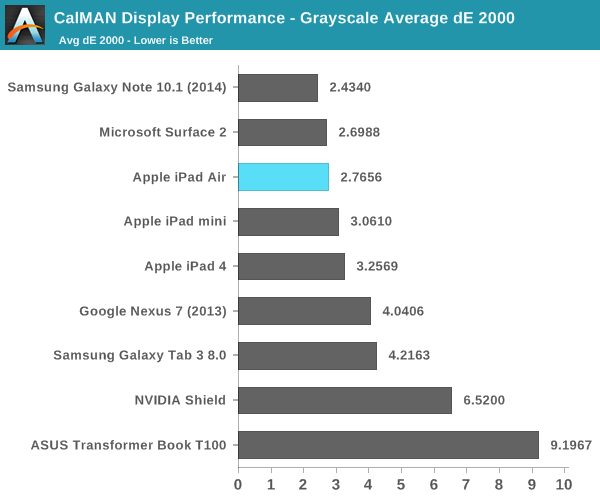
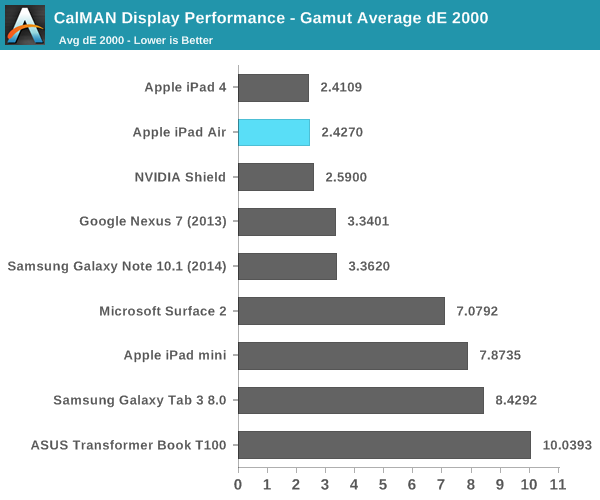



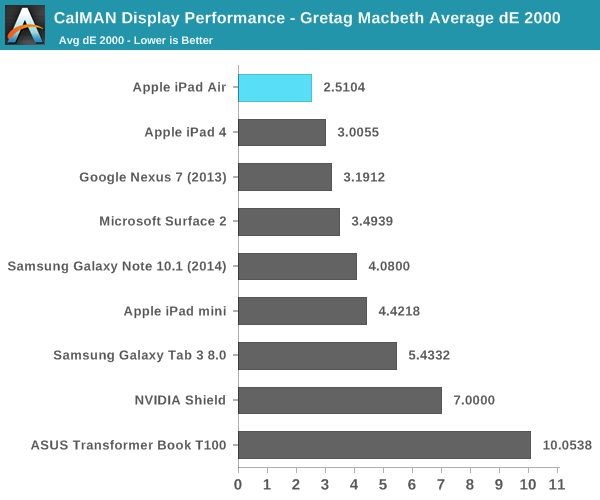

The iPad Air gets pretty bright at 426 nits, although black levels aren’t all that impressive at 0.44 nits. Overall contrast ratio is in line with what we’ve seen from previous iPads. My only complaint on the display front is I would like to see Apple laminate the cover glass to the LCD display. Reducing reflections would go a long way towards improving the usability of the device, not to mention the impact that would have on improving display quality in dark movie scenes.
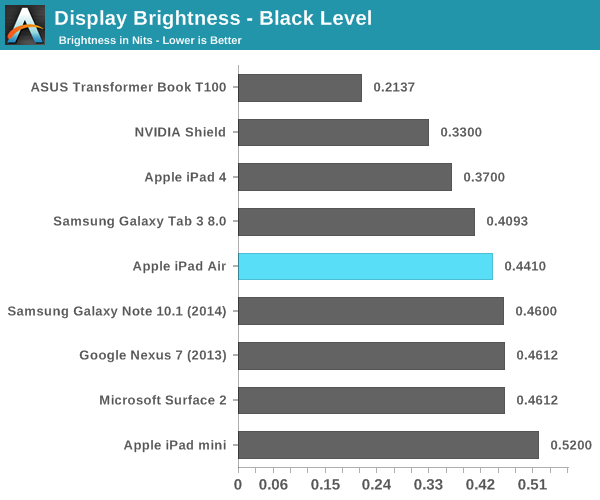
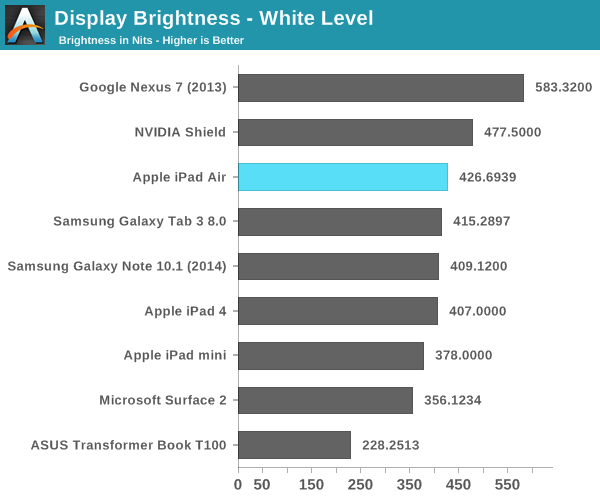
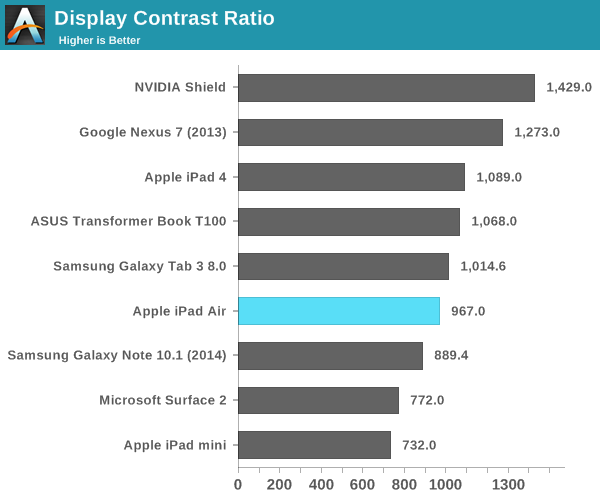















444 Comments
View All Comments
AldenG - Wednesday, October 30, 2013 - link
Not including the Kindle Fire HDX in the comparison does seem to be a glaring oversight as other sites have posted benchmarks that show it is roughly 2x the power of the Nexus 7. I actually read this review trying to decide between them, and this makes it really hard. As an iPad owner AND Amazon Prime subscriber, I'm on the fence, and was hoping this review would tip the balance. Anand, please update with Kindle specs, too.coolhardware - Wednesday, October 30, 2013 - link
It is pretty crazy that the tablet line that introduced the 'retina' moniker is not in the top 10 anymore in pixel density:http://pixensity.com/list/tablet/
I understand many people say pixel density beyond Apple's dictated/calculated points is irrelevant, but from a technical standpoint it is really cool to see these other ultra high res displays out there :-)
Regardless, Apple does make nice tablets and I do plan on replacing my wife's iPad 3 with an iPad Air (mainly since her iPad 3 has been laggy since upgrading to iOS 7).
ssiu - Wednesday, October 30, 2013 - link
The 7" Kindle Fire HDX is not in the list (should be #3 at 323 PPI)coolhardware - Wednesday, October 30, 2013 - link
Good call! You can submit a device here: http://pixensity.com/add/Along those same lines of new tablets, I am excited to see the new HDX 8.9 and the new Nexus 10 (maybe Nov 5th?)
choch0 - Wednesday, October 30, 2013 - link
does anyone know where Anand got the colored triangle wallpaper he used on his ipad air for the review photos? i love the wallpaper! any help/feedback would be greatly appreciated.Commodus - Wednesday, October 30, 2013 - link
That's actually built into iOS 7 (not the default).deathBOB - Wednesday, October 30, 2013 - link
Anand, what has changed to drop display power usage?lilo777 - Wednesday, October 30, 2013 - link
"You can see the 5s throttles back its CPU frequency to about 1GHz after the 2 minute mark. The crazy thing is that until that point the 5s manages to run at full frequency without so much as a hiccup for two full minutes, running an incredibly power hungry task. Given that most iOS apps aren’t this power intensive for such a sustained period of time, iPhone 5s users should almost always see the A7 running at a full 1.3GHz. Pretty crazy."Also crazy is the fact that somehow Anand decided not to call this benchmark cheating unlike what he did with Android tests.
carbonsx - Wednesday, October 30, 2013 - link
"Also crazy is the fact that somehow Anand decided not to call this benchmark cheating unlike what he did with Android tests."Isn't it though... There is no way that the A7 will always be running at a full 1.3GHz for thermal and battery life reasons, other than during a benchmark. This statement makes absolutely no sense:
"Given that most iOS apps aren’t this power intensive for such a sustained period of time, iPhone 5s users should almost always see the A7 running at a full 1.3GHz. Pretty crazy."
Pretty crazy indeed.
tgibbs - Wednesday, October 30, 2013 - link
Benchmark cheating is not the processor throttling down when driven hard for a period of time--in fact, it is the exact opposite. Benchmark cheating is the device recognizing a benchmarking app and entering a special mode where it does *not* throttle down--even though it would do so if any other app were hitting the processor that hard.